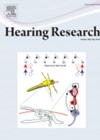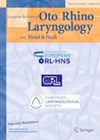
Journal Reviews
Not to be mis-underestimated
It is a very rare occurrence to find a paper looking at NF2 and the auditory system. There seems to only be a couple on NF2 prevalence in the population, so this is unsurprising. As far as I can recall...
Transverse venous sinus stenosis – a risk factor for CSF leak in patients with idiopathic intracranial hypertension
This was a multicentre (six French tertiary hospitals) retrospective case-controlled study aiming to investigate the rate of transverse venous sinus stenosis (TVSS) in patients with idiopathic intracranial hypertension (IIH) with nasal cerebrospinal fluid (CSF) leaks. They compared the preoperative MRI...
The decision-making process by parents of children with residual hearing who receive cochlear implants
It can be a difficult decision for parents whose children have residual hearing whether or not to undergo cochlear implantation. Their children may seem to be hearing with their hearing aids, and even in some cases can hear without aids....
Does middle turbinate resection affect olfaction in endoscopic transsphenoidal surgery?
The middle turbinates (MT) are sometimes partially resected during endoscopic transnasal transsphenoidal pituitary surgery to improve surgical access. Some outfracture the middle turbinates instead. This article presents results of the first prospective randomised study, investigating the effects of such surgery...
Endolymphatic sac tumours
The authors performed a systematic review of literature and describe the clinical signs and symptoms of endolymphatic sac tumours (ELST) in this article. A total of 113 patients and 118 cases from 26 studies were included in the study. The...
Global incidence of sporadic vestibular schwannoma
The incidence rate of sporadic vestibular schwannoma (VS) has commonly been quoted as one in 100,000. However, since the advent of screening for asymmetrical hearing loss and increased availability of modern MRI scanning, more recent studies have shown the incidence...
Corticosteroid prescribing in ENT - are we at risk of being sued?
Of medications leading to malpractice claims, corticosteroids comprise the third most common. They are used widely and have a significant side-effect profile: hypertension, lipodystrophy, diabetes, avascular necrosis of the femoral head, peptic ulceration and psychiatric reactions to name but a...
Molecular and genetic nature of skull base tumours drives management
This article reviews the molecular basis and paradigm shift in the diagnosis and management of skull base tumours. It is now known that the phenotype of meningiomas is influenced by their genotype. Endolymphatic sac tumours are observed in up to...
QoL post-endoscopic hypophysectomy
This prospective study conducted over four years surveyed more than 300 patients after endoscopic pituitary adenoma resection. The authors used the Anterior Skull Base Questionnaire-35 and the Sinonasal Outcome Test-22, and the scores were analysed for quality of life (QoL)...
Are there any benefits of postoperative antibiotics after endoscopic transsphenoidal surgery for pituitary tumours?
This prospective randomised double-blind multicentre study evaluated whether postoperative antibiotics resulted in improvement in sinonasal quality of life (QoL) compared to placebo in patients undergoing endoscopic endonasal transsphenoidal pituitary surgery. A total of 461 patients were screened for the study...
Which factors affect the postoperative CSF leak following endoscopic skull base surgery?
Endoscopic skull base surgery is being increasingly performed worldwide for skull base tumours. Common indications include pituitary tumours, rathke cleft cysts, chordomas, craniopharyngiomas and olfactory neuroblastomas. The most common and important complication following endoscopic skull base surgery is postoperative CSF...
Treatment of internal carotid artery blowout with embolisation and bypass grafting (nasopharyngeal carcinoma)
Carotid artery blowout syndrome (CBS) occurs when there is rupture of the carotid artery causing massive epistaxis and bleeding through the oral cavity caused by tumour invasion, surgery, radiotherapy, or infection. This article proposes a revascularisation strategy for internal carotid...
















